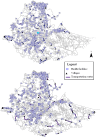The nexus between geographical distance and institutional delivery trends in Ethiopia: evidence from nationwide surveys
- PMID: 39314844
- PMCID: PMC11418825
- DOI: 10.7717/peerj.18128
The nexus between geographical distance and institutional delivery trends in Ethiopia: evidence from nationwide surveys
Abstract
Background: Giving birth in a healthcare facility with the guidance of skilled healthcare providers allows access to necessary medical interventions. Ethiopia has implemented several strategies to enhance institutional delivery and decrease maternal mortality; however, the rate of institutional delivery remains low. This study examines the role of distance to healthcare institutions on institutional delivery in Ethiopia, and how this has changed over time.
Method: This study used data from two rounds of the Ethiopian Demographic and Health Survey (2011 and 2016), a spatial database detailing the locations of healthcare facilities, and Ethiopian road network data. The sample included 22,881 women who delivered within the 5 years preceding each survey and lived in 1,295 villages. Bivariate and multivariable logistic regression analyses were used to investigate how the distance to health facilities and other potential determinants influenced institutional delivery trends.
Results: The rate of institutional deliveries in Ethiopia has increased from 10% in 2011 to 26% in 2016. Likewise, the average transportation distance to health facilities has decreased from 22.4 km in 2011 to 20.2 km in 2016 at the national level. Furthermore, a one-kilometer increase in the distance to the nearest health facility was associated with a 1% decrease in the likelihood of delivering at a health facility in 2016 (odds ratio (OR) = 0.99, 95% CI [0.98-0.99], p < 0.05). Additionally, mothers who are more educated, have completed more antenatal care visits, live in wealthier households in more urban areas, and cohabit with more educated husbands are more likely to deliver at healthcare facilities. These variables showed consistent relevance in both survey rounds, suggesting that key determinants remained largely unchanged throughout the study period.
Conclusion: The impact of distance from health facilities on institutional delivery in Ethiopia remains evident, although its influence is relatively modest. The other factors, including education, antenatal care, socioeconomic status, urban residence, and partner education, remained consistent between the two surveys. These determinants have consistently influenced institutional delivery, highlighting the importance of a comprehensive approach that addresses both access to and socioeconomic factors to improve maternal and infant health across the country.
Keywords: Accessibility of health services; Distance to health facilities; Facility delivery; Facility distance; Institutional delivery; Maternal health.
© 2024 Sebsibe and Kebede.
Conflict of interest statement
The authors declare that they have no competing interests.
Figures




Similar articles
-
Determinants of institutional delivery service utilization in Ethiopia: a population based cross sectional study.BMC Public Health. 2020 Jul 8;20(1):1077. doi: 10.1186/s12889-020-09125-2. BMC Public Health. 2020. PMID: 32641020 Free PMC article.
-
Facility delivery and postnatal care services use among mothers who attended four or more antenatal care visits in Ethiopia: further analysis of the 2016 demographic and health survey.BMC Pregnancy Childbirth. 2019 Feb 11;19(1):64. doi: 10.1186/s12884-019-2216-8. BMC Pregnancy Childbirth. 2019. PMID: 30744583 Free PMC article.
-
The effects of geographical accessibility to health facilities on antenatal care and delivery services utilization in Benin: a cross-sectional study.Reprod Health. 2021 Oct 14;18(1):205. doi: 10.1186/s12978-021-01249-x. Reprod Health. 2021. PMID: 34649581 Free PMC article.
-
The effect of antenatal care on use of institutional delivery service and postnatal care in Ethiopia: a systematic review and meta-analysis.BMC Health Serv Res. 2018 Jul 24;18(1):577. doi: 10.1186/s12913-018-3370-9. BMC Health Serv Res. 2018. PMID: 30041655 Free PMC article.
-
Predictors of institutional delivery service utilization in Ethiopia: an umbrella review.BMC Pregnancy Childbirth. 2025 Mar 21;25(1):332. doi: 10.1186/s12884-025-07464-9. BMC Pregnancy Childbirth. 2025. PMID: 40119253 Free PMC article.
Cited by
-
Maternal health care services utilization and associated factors among pregnant women in Kersa district, Jimma zone, Southwest Ethiopia.PLoS One. 2025 May 29;20(5):e0323977. doi: 10.1371/journal.pone.0323977. eCollection 2025. PLoS One. 2025. PMID: 40440314 Free PMC article.
References
-
- Abdulkadr AA, Juma LO, Gogo AF, Neszmélyi GI. East African transport infrastructure: the cases of Ethiopia, Kenya and Tanzania. Regionalnaya ekonomika. Yug Rossii [Regional Economy. South of Russia] 2022;10(4):82–91.
-
- Burgert CR, Colston J, Roy T, Zachary B. Geographic displacement procedure and georeferenced data release policy for the Demographic and Health Surveys. Reston, Virginia, USA: ICF International; 2013.
-
- Central Statistical Agency (CSA) [Ethiopia] and ICF . Ethiopia Demographic and Health Survey 2011. Addis Ababa, Ethiopia, and Rockville, Maryland, USA: CSA and ICF; 2012.
MeSH terms
LinkOut - more resources
Full Text Sources
Medical

